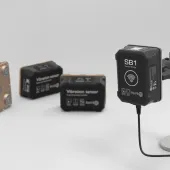Haver & Boecker launch new Ty-Rail configurations

Three new angle-box designs increase the adaptability of Tyler-brand vibrating screens
HAVER & Boecker have introduced new configurations of their Ty-Rail quick-tensioning system for screen media. As a result of Ty-Rail’s success, the company now offers three angle-box designs for different vibrating screen setups, providing time-saving benefits for producers during screen media change-outs, even on difficult-to-access areas of a vibrating screen.
The patented Ty-Rail system is designed specifically for Haver & Boecker’s Tyler brand of vibrating screens and now comes standard on all new F-Class and T-Class machines with three- bend tension rails.
The system solves a longstanding problem of time-consuming screen media change-outs. Replacing tension rails typically requires the removal and replacement of many pieces of hardware per screen section. Ty-Rail eliminates this problem by combining the tension rail and all of its hardware into one piece, and the new angle-box designs provide the ability to change screen media in half the time, even in tight or hard-to-reach areas.
‘Our goal is to continually develop new ways to help our customers achieve more productivity,’ said Karen Thompson, president of Haver & Boecker Canada. ‘Our patented Ty-Rail system is just one way we are achieving that goal. The feedback from customers and the positive impact on their operations encouraged us to develop additional configurations to accommodate more screen designs and applications.’
The standard Ty-Rail configuration requires operators to loosen bolts and shift the angle-box gates up to remove the tension rail. Whilst this is ideal in easily accessible areas of a vibrating screen, some screen designs can limit access to some of the tensioning bolts. Haver & Boecker have, therefore, engineered two additional angle box designs for reverse and tight areas.
The reverse design allows maintenance technicians to loosen and remove bolts from the inside of the vibrating screen instead of the outside, thereby eliminating the tedious task of using an open-end wrench to access difficult areas, whilst he tight-area design flips the angle box 180° from the standard angle-box configuration, allowing producers to loosen the bolts and drop the angle box gate rather than lift it up. A reinforced strap secures the gate during screen media change-out.
Each Ty-Rail package includes two tension rails, eight angle boxes, eight bolts and all the hardware required to change one screen section. Once installed, each rail becomes a singular, removable piece, as the bolts remain attached to the rail and the angle boxes remain attached to the vibrating screen.
To remove the tension rails, an operator simply loosens the tension bolts on each, shifts the angle box gates up, and lifts the rail and bolts out as one piece. The innovation means the task of changing tensioned screen media panels can be done by one person instead of two.
Producers can also refurbish older Tyler vibrating screens that have three-bend tension rails with the Ty-Rail system. To determine if Ty-Rail can be installed on a non-Tyler brand of vibrating screen, producers should consult the measurement guide at: havercanada.com/Ty-Rail









